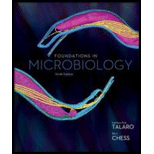
Explain the ways that mitochondria resemble rickettsias and chloroplasts resemble cyanobacteria.
To analyse:
The similarities that mitochondria have with rickettsias and those that chloroplasts have with cyanobacteria.
Introduction:
According to the endosymbiotic theory, eukaryotic cells developed from prokaryotic cells when smaller prokaryotes were engulfed by larger ones. These engulfed cells gradually attained the ability to survive and reproduce within the host. Over millions of years, these smaller prokaryotes became organelles of the bigger cell and thus, eukaryotes were formed. This theory is supported by striking similarities between some prokaryotes and organelles like mitochondria and chloroplasts.
Explanation of Solution
Mitochondria and rickettsias have a lot of structural and functional similarity. Rickettsias are obligate parasites and are unable to survive outside the body of a host. Likewise, mitochondria are also functional only as a part of a eukaryotic cell. Mitochondria divide independently of the cell, possess prokaryotic ribosomes and contain a circular DNA strand, pointing to their origin from a prokaryote like rickettsia.
Similarly, a lot of similarities exist between cyanobacteria and chloroplasts. Both of these have pigments like chlorophyll inside. The structure of chloroplasts and cyanobacteria is also quite similar.
Due to striking structural and functional similarities, mitochondria are thought to have evolved from rickettsias and chloroplasts are thought to have evolved from cyanobacteria.
Want to see more full solutions like this?
Chapter 5 Solutions
Foundations in Microbiology
- Create a Venn diagram that depicts the similarities and differences between prokaryotes, and the eukaryotic organelles, mitochondria and chloroplasts.arrow_forwardhow are mitochondria and chloraplasts similar to prokaryotes?arrow_forwardDifferentiate a photosynthetic prokaryotes from a photosynthetic eukaryotes .arrow_forward
- Where does the reaction of photosynthesis take place in the prokaryotes? A. Outer membrane B. Cristae C. Nucleoid D. Cytoplasm E. Thylakoidsarrow_forwardExplain the differences between cyanobacteria and algae. What are the differences between paramecium, amoeba, and euglena?arrow_forwardName two similarities in the structure or function of chloroplasts and mitochondria. Name two differences.arrow_forward
- Explain, Which of the following plays an important part in photosynthesis? A) Chloroplast B) Centrosome C) Tonoplast D) Nematoblastarrow_forwardIdentify: 11. Single mitochondrion with large DNA associated with the basal body in the Trypanosome’s.arrow_forwardmake a comparison table of chloroplast and mitochondriaarrow_forward
- Name and describe the idea that explains how mitochondria and chloroplasts are thought to have originated in eukaryotic cells.arrow_forwardGive one significant difference between Eucaryotes and Prokaryotes.arrow_forwardThe Prokaryotes are associated with the following structures EXCEPT: A) ribosomes, B) Lysosomes and liposomes, C) a nucleoid area, D) mesosomes, E) chlorophyll.arrow_forward
 Human Anatomy & Physiology (11th Edition)BiologyISBN:9780134580999Author:Elaine N. Marieb, Katja N. HoehnPublisher:PEARSON
Human Anatomy & Physiology (11th Edition)BiologyISBN:9780134580999Author:Elaine N. Marieb, Katja N. HoehnPublisher:PEARSON Biology 2eBiologyISBN:9781947172517Author:Matthew Douglas, Jung Choi, Mary Ann ClarkPublisher:OpenStax
Biology 2eBiologyISBN:9781947172517Author:Matthew Douglas, Jung Choi, Mary Ann ClarkPublisher:OpenStax Anatomy & PhysiologyBiologyISBN:9781259398629Author:McKinley, Michael P., O'loughlin, Valerie Dean, Bidle, Theresa StouterPublisher:Mcgraw Hill Education,
Anatomy & PhysiologyBiologyISBN:9781259398629Author:McKinley, Michael P., O'loughlin, Valerie Dean, Bidle, Theresa StouterPublisher:Mcgraw Hill Education, Molecular Biology of the Cell (Sixth Edition)BiologyISBN:9780815344322Author:Bruce Alberts, Alexander D. Johnson, Julian Lewis, David Morgan, Martin Raff, Keith Roberts, Peter WalterPublisher:W. W. Norton & Company
Molecular Biology of the Cell (Sixth Edition)BiologyISBN:9780815344322Author:Bruce Alberts, Alexander D. Johnson, Julian Lewis, David Morgan, Martin Raff, Keith Roberts, Peter WalterPublisher:W. W. Norton & Company Laboratory Manual For Human Anatomy & PhysiologyBiologyISBN:9781260159363Author:Martin, Terry R., Prentice-craver, CynthiaPublisher:McGraw-Hill Publishing Co.
Laboratory Manual For Human Anatomy & PhysiologyBiologyISBN:9781260159363Author:Martin, Terry R., Prentice-craver, CynthiaPublisher:McGraw-Hill Publishing Co. Inquiry Into Life (16th Edition)BiologyISBN:9781260231700Author:Sylvia S. Mader, Michael WindelspechtPublisher:McGraw Hill Education
Inquiry Into Life (16th Edition)BiologyISBN:9781260231700Author:Sylvia S. Mader, Michael WindelspechtPublisher:McGraw Hill Education





